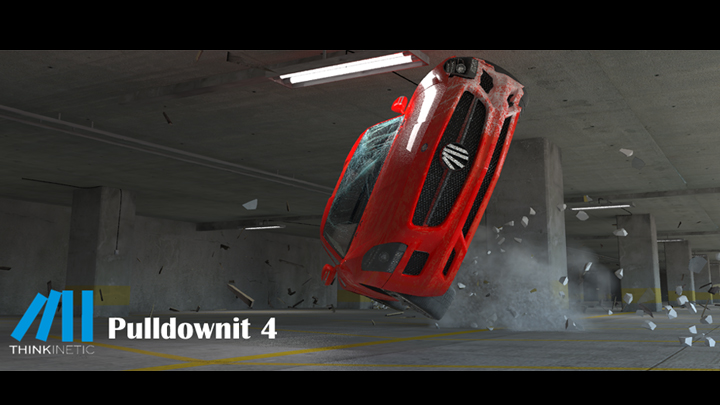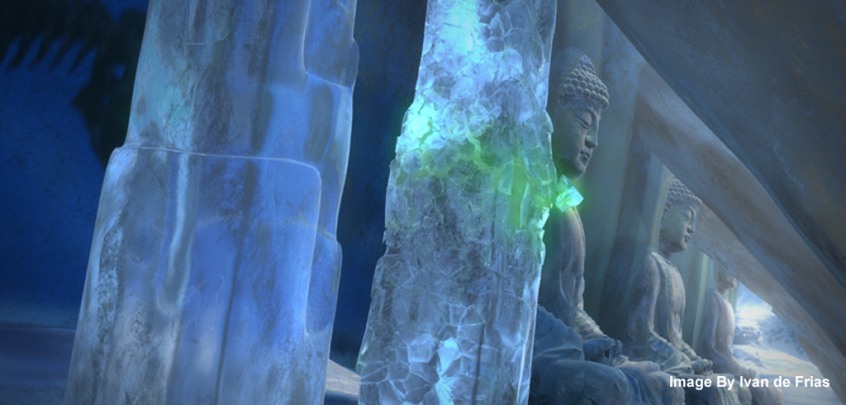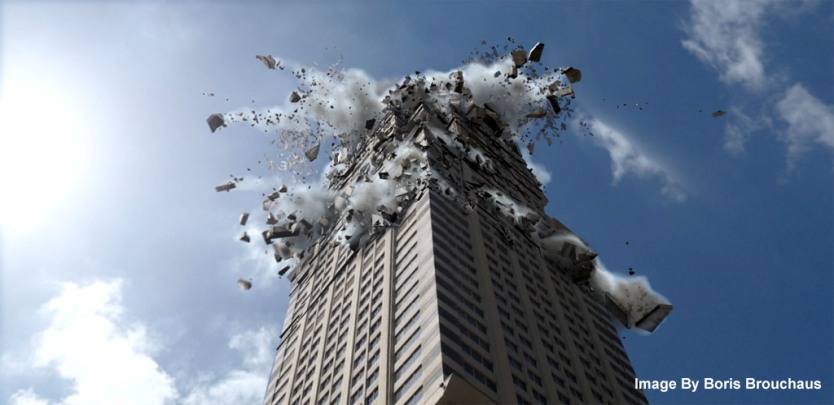Check out in-depth technical details of VFX Dynamics plugin: Pulldownit from Thinkinetic.

Carlos Pegar is co-founder of Thinkinetic company and Product Manager of Pulldownit plugin. Pulldownit is a destruction tool integrated in Autodesk 3ds Max and Maya. By using its Dynamics technology, digital artists are able to simulate fast and easily the collapse of buildings, cracking surfaces or fracturing any kind of brittle material.
We thanks Jose Garcia Freire, Thinkinetic Sales & Marketing for arranging this exclusive interview.
Hi Carlos. What was the need of exclusive Dynamics plugin like Pulldownit?
Hi Amit, 20 years ago making believable destruction effects was only possible for large studios using models. At that time they used to build scale models of buildings to destroy them and film it. It was a tremendous task with hundreds of people involved and only one chance to do it because once the structure has blowing up, you cannot “reset” and start again.
Computer hardware and software has evolved drastically and today you can see quality destruction effects in movies, TV series and even commercials. All using exclusively CG models and computer tools. You can reset the scene, make changes, save different takes of the same effect and choose the one you prefer; even one single person can achieve realistic destruction effects if he/she counts with the correct tools and knowledge.
Pulldownit plugin appeared in 2009 to allow artists to destroy CG models easily, from statues to large structures. The 3D dynamics plugin is currently integrated inside Autodesk 3ds Max and Maya. The built-in dynamics tools of these platforms wasn’t able and still aren’t to compute realistic fracture effects, so if you want to do create massive destruction, you need a specific plugin like Pulldownit.
What are unique features of Pulldownit?
Pulldownit from Thinkinetic combines an accurate shatter tool and a fast and stable dynamics solver. You can use these tools independently, but its major advantages comes when using both together. The dynamics solver build a fracture object based in the shape of the shards generated, optimizing speed of computation and detecting different fracture areas to generate cracks and debris, so you can get perfect fracture results very quickly. In fact, our users says Pulldownit makes it simple compare to what you need a Master degree in Physics and Programming using other tools.
In latest version, we have added some relevant features for production. Adquire Shatter makes possible to transfer shatter effects and animation to another version of the same asset, for example if your studio eventually decides to change the textures of the model you can reuse your current effect seamlessly. Besides Jagginess feature has been widely extended, with more controls to adjust the rough look of broken fragments and keeping a low rate of “jaggy faces” in hi-poly meshes, this is time saving when rendering the scene.

Pulldownit can handle massive rigid body simulations. Let us know the minimum and ideal hardware requirements.
Pulldownit is fully integrate in 3ds Max and Maya. Therefore, the hardware requirements are the same ones of these platforms, any supported GPU by Maya or 3ds Max should work. You can compute multi threaded but even the single threaded mode is very fast. So, it doesn’t mind the number of cores really, however for massive simulations with thousands of fragments, 16GB of RAM is highly recommended to speed up things.
How tightly Pulldownit from Thinkinetic is integrated with Particles and Fluid based simulations?
That’s a good question. As any realistic destruction effect needs dust and smoke around, so we have had this in account when designing the tool. Whatever software do you use for doing a destruction shot, it involves several stages. First you define the amount and shape of the fragments, then you compute dynamics for these fragments to make the model crumbling and collapse, finally you have to add all these funny things such as extra debris, dust and smoke.
Pulldownit perfectly fits in this workflow, the final result of computations is raw geometry, vertices and faces, and standard animation keys, so you can emit particles or fluids from the fragments in the usual way and make them acquire the fragments motion using Maya particles or fluids, or using Particle flow in 3ds Max. We have technical tutorials about adding particles to simulations in our web site. Check them out.
Breaking columns with Pulldownit 3 and adding particles debris in Maya
Breaking columns with Pulldownit 3 and adding pFlow debris in 3DMax
Pulldownit plugin is specifically written for scenarios like shatter, destruction, fracture and related. Can you suggest any other creative uses?
Well, our focus is to make the best tool possible for shatter and destruction effects, because of this PDI counts with a very fast dynamics solver. You can use it perfectly for classic “many bodies” simulations like a bowling game. Besides you can easily set parameters away from realistic values to get suggestive or hyper realistic behavior. PDI can handle thousands of objects in dynamics colliding each other while being affected by force fields like Newton, Wind, Gravity, turbulence, etc. So it is a great tool for Motion Graphics projects as well.
I remember now some of our costumers have used it to ensemble objects from pieces just by playing the simulation in the reverse sense that’s an interesting effect.
Currently your plugin supports only Autodesk Maya and 3ds Max. What about other 3D softwares?
Currently there are no plans to integrate the plugin in other 3D packages like Houdini, Blender, Cinema 4D and others.
You can export PDI scenes using popular cross-platform formats like fbx or alembic. We know some studios which transfers scenes back and forth between Maya and Houdini. You can do the same with PDI scenes to continue adding more details like smoke or dust. This is also the perfect way to import PDI scenes into UE4 or Unity. Many of our users does it in this way and I can say it works perfectly.

Let us know about different product versions.
Pulldownit from Thinkinetic is fully integrated in the target platform, so you cannot use Pulldownit of Maya in 3ds Max neither the opposite. If you use both 3ds Max and Maya, you can license both platforms. We offer a bundle for this at a reduced cost. Of course the plugin works much the same in both of them, aside the idiosyncrasy of each platform. However there is a connection between PDI in 3ds Max and Maya, for example in case you want to transfer a PDI scene done in 3ds Max to Maya, you would have to bake keys and use fbx or alembic format.
Besides Autodesk Maya is available for Windows, Mac and Linux. Same for Pulldownit, so you have to choose the correct system in our shop. You can use the plugin only in the system you have licensed it.
Please share some of the best case studies.
Case studies are reported by users kindly explaining its experience using Pulldownit in different projects. You can find them in the “User Stories” page of Thinkinetic web site.
I think it doesn’t make sense to say if one is better than another. All of them are interesting to read and the important thing is you can find their feedback about the use of the tool. So, if you are planning to collapse a building you can find several case studies about this topic. If your project involves an animated character with dynamic interaction, there are some very nice stories as well and so on. We always appreciate users reporting us their experience with the tool and I suppose this can be helpful for other users facing similar projects.
What are production credentials of Pulldownit?
Pulldownit is being used in both Games industry and VFX industry. Several large studios has licensed the plugin in past years. In recent credentials, Pulldownit is used recently in ‘Uncharted 4’ and before in some ‘Gears of War’ extension packs. Some years ago Pulldownit was used by Cinesite for several destruction effects in Harry Potter VIII and various other blockbuster movies. Recently some studios involved in TV series has licensed the plugin but I really don’t know what are they using it for at this moment. Worth to mention, among our users, there are many small studios and freelancers which uses PDI for destruction effects mostly in commercials.
What can we expect in future release of the plugin?
CG Fracture is very new field and there are different workflows to explore. Besides, we have learned users likes fast iterations and responsiveness when working in dynamics, so we will continue improving the tool in this sense, and of course adding more cool features to make 3D models crack, crumble and break apart.
More the destruction, more the fun!
Thanks again to Carlos and Jose for such great interview. Also check out image gallery of various simulation works achieved by Pulldownit from Thinkinetic.



